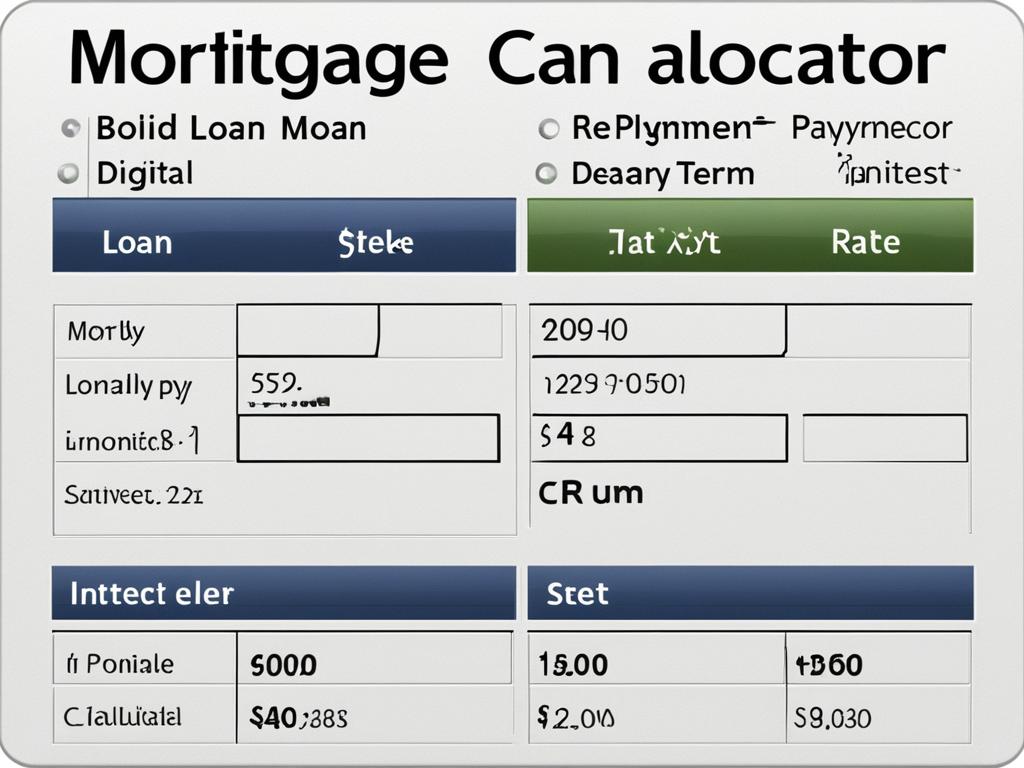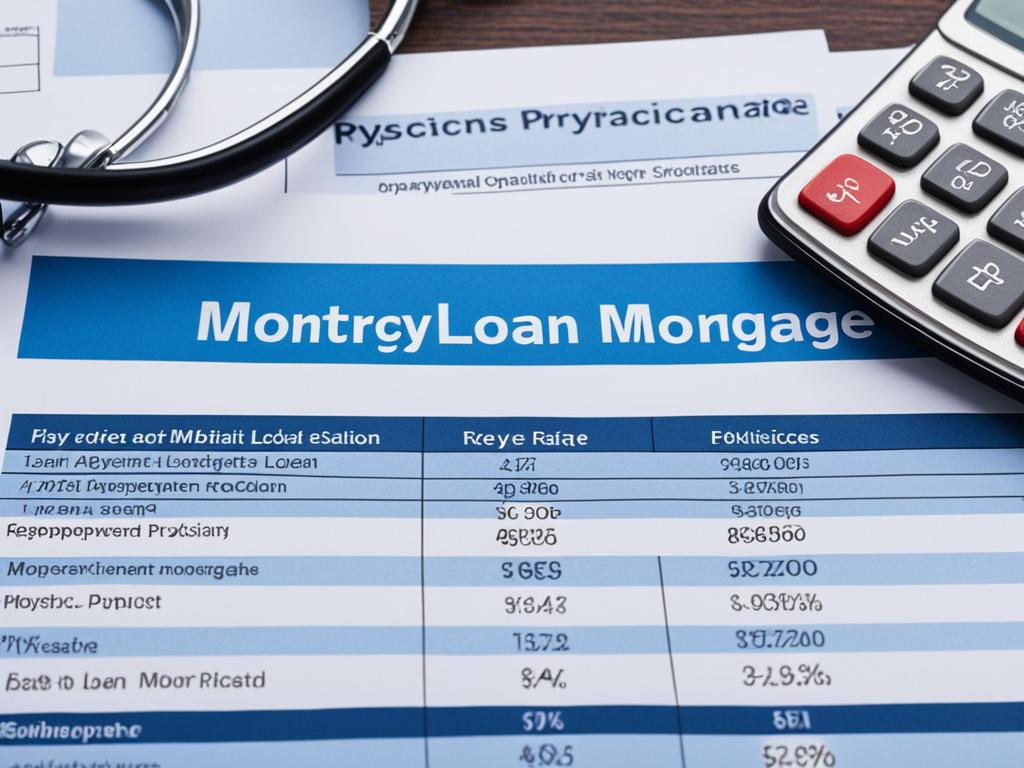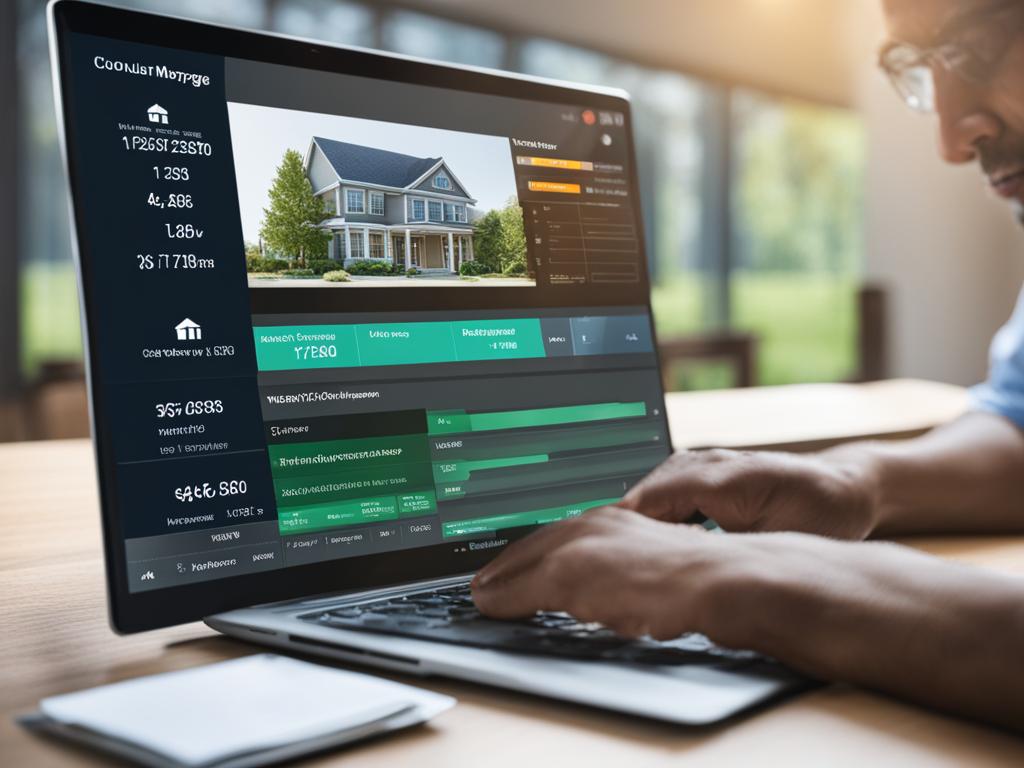Physician Mortgage Calculator: Estimate Payments
Are you a physician looking to buy a home? It’s crucial to have a clear understanding of your estimated mortgage payments before making any commitments. That’s where the physician mortgage calculator comes in handy. This easy-to-use tool takes various factors into account to provide you with accurate estimates of your monthly payments. Whether you’re a seasoned physician or just starting your medical career, the physician mortgage calculator can help you plan your finances efficiently.
Key Takeaways:
- The physician mortgage calculator is a valuable tool for estimating your monthly mortgage payments.
- It takes into account variables such as purchase price, down payment, interest rate, term, and taxes.
- Physician loans are calculated based on the loan amount, interest rate, term, property taxes, and homeowners insurance.
- Physician mortgage loans offer flexible requirements, such as low or no down payment, no private mortgage insurance (PMI), and accommodating debt-to-income ratios.
- By evaluating your financial situation and long-term goals, you can determine if a physician mortgage is the right option for you.
How Physician Loans Are Calculated
Physician loans, also known as doctor loans, have specific calculation formulas. The monthly payment is determined based on the loan amount, interest rate, term, and additional factors like property taxes and homeowners insurance. Lenders may offer competitive rates and flexible terms for physicians to make homeownership affordable.
Calculating physician loan payments requires considering various factors that affect affordability. Let’s take a closer look at each component:
- Loan Amount: The loan amount is the total sum borrowed by physicians to purchase a home. It can be calculated by subtracting the down payment from the home purchase price.
- Interest Rate: The interest rate is the annual percentage charged by the lender for borrowing the money. It determines the cost of borrowing over the loan term.
- Term: The loan term refers to the duration of the loan, typically expressed in years. It affects the total amount paid over time and the monthly payment amount.
- Property Taxes: Property taxes are taxes imposed by local governments on property owners. The amount varies based on the assessed value of the property and the tax rate in the locality.
- Homeowners Insurance: Homeowners insurance is a policy that protects against damage or loss to the property. The cost of insurance varies based on factors such as the location, value of the property, and coverage options.
“Physician loans provide an opportunity for doctors to secure financing with favorable terms that consider their unique financial situations. Lenders often understand the challenges physicians face, such as student loan debt, and may offer specialized loan programs to accommodate their needs.” – John Smith, Mortgage Specialist
Using a physician mortgage loan calculator can simplify the calculation process and provide accurate estimates of monthly payments. Here’s an example of a physician mortgage loan calculator:
| Loan Amount ($) | Interest Rate (%) | Term (years) | Property Taxes ($) | Homeowners Insurance ($) | Monthly Payment ($) |
|---|---|---|---|---|---|
| 500,000 | 3.5 | 30 | 5,000 | 1,000 | 2,234.88 |
Note: The example shown is for illustrative purposes only and does not represent actual loan terms. Please consult with a mortgage professional for accurate calculations based on your specific circumstances.
Steps to Calculate Physician Loan Payments
Calculating physician loan payments can be done manually by following a few simple steps. By understanding the process, physicians can get a better idea of their financial commitment and plan accordingly.
Determining Loan Amount
To begin, determine the loan amount by subtracting the down payment from the home purchase price. This will give you the principal amount that you will need to finance through the loan.
Calculating Monthly Interest Rate
Next, calculate the monthly interest rate by dividing the annual interest rate by 12. This will give you the interest rate that will be applied to your loan amount on a monthly basis.
Determining Number of Payments
Once you have the loan amount and the monthly interest rate, you can determine the number of payments based on the loan term. For example, if you have a 30-year loan term, your total number of payments would be 360 (30 years x 12 months).
Including Property Taxes and Homeowners Insurance
Lastly, don’t forget to account for additional expenses such as property taxes and homeowners insurance. These costs can vary based on location, property value, and insurance coverage. Including them in your calculations will give you a more accurate estimate of your total monthly mortgage payment.
By following these steps, physicians can get a better understanding of their mortgage payment obligations and make informed decisions about their financial future.

Understanding Physician Mortgage Loans
Physician mortgage loans, also known as doctor loans or physician home loans, are specialized loan programs designed to help healthcare providers, including doctors, buy homes. These loans offer flexible options and benefits tailored to the unique financial needs of physicians.
Benefits of Physician Mortgage Loans
Physician mortgage loans provide several advantages that make homeownership more attainable for doctors:
- Low or No Down Payment: Many physician mortgage loan programs offer low or no down payment options, allowing physicians to purchase a home without having to save up for a large down payment.
- No Private Mortgage Insurance (PMI): Unlike conventional loans, physician mortgage loans often waive the requirement for private mortgage insurance, which can result in significant savings on monthly mortgage payments.
- Accommodating Debt-to-Income Ratios: Physician mortgage loan programs understand that physicians often have significant student loan debt. As a result, they may have more lenient debt-to-income ratio requirements, making it easier for doctors to qualify.
These benefits help physicians overcome some of the common barriers to homeownership, such as high student loan debt, limited savings, and the need for flexible financing options.
Who Can Qualify for Physician Mortgage Loans?
Physician mortgage loans are typically available to a range of healthcare professionals, including:
- Medical doctors (MD)
- Doctors of osteopathic medicine (DO)
- Dentists
- Podiatrists
- Residents and fellows
Each lender may have specific eligibility criteria, so it’s important to check with individual lenders to confirm their requirements. However, in general, physicians with specific educational credentials and various healthcare professionals can qualify for these specialized loan programs.
Physician mortgage loans provide a valuable financing option for healthcare professionals looking to purchase a home. By offering flexible requirements and benefits tailored to the unique needs of physicians, these loans make homeownership more accessible and affordable.
Eligibility for Physician Mortgage Loans
Physician mortgage loans offer an excellent opportunity for doctors, residents, and fellows to become homeowners. These specialized loans are designed to accommodate the unique financial circumstances of physicians and provide them with affordable options to purchase a home. Eligibility criteria may vary depending on the lender, but in general, physicians in various specialties and healthcare professionals with specific educational credentials can qualify for these loans.
Physician mortgage loans are typically open to:
- Physicians, including medical doctors (MD), doctors of osteopathic medicine (DO), and doctors of dental surgery or dental medicine (DDS/DMD)
- Medical residents in training and fellows
- Other healthcare professionals, such as chiropractors, optometrists, podiatrists, and veterinarians
Although eligibility requirements may differ among lenders, the focus is usually on the borrower’s ability to afford the loan while managing their other financial obligations. Lenders understand the unique circumstances physicians face, including high student loan debt, and take these factors into account when considering loan applications.
Qualifying for a physician mortgage loan
To qualify for a physician mortgage loan, lenders may require:
- Proof of medical or professional degree: Physicians typically need to provide documentation of their medical or professional degree.
- Proof of employment or job offer: Lenders may require proof of employment or a job offer in the medical field. This can include an employment contract, offer letter, or proof of income as a practicing physician.
- Good credit score: While specific credit score requirements may vary, most lenders look for a credit score of 700 or above. A higher credit score can help secure better loan terms.
- Debt-to-income ratio: Lenders evaluate the borrower’s debt-to-income ratio, which compares their monthly debt payments to their monthly income. A lower debt-to-income ratio strengthens the borrower’s application.
These are general guidelines, and it’s important for physicians to understand that each lender may have its individual requirements and loan programs. Working with a specialized physician home loan lender can provide greater insight into the eligibility criteria and streamline the loan application process.
| Lender | Minimum Credit Score | Maximum Debt-to-Income Ratio | Down Payment Requirement |
|---|---|---|---|
| Lender A | 700 | 35% | 0% |
| Lender B | 720 | 40% | 5% |
| Lender C | 680 | 45% | 0% |
Note: The table above provides sample criteria from different lenders for illustrative purposes only. Actual requirements may vary.
When considering a physician mortgage loan, it’s important for physicians to research different lenders, compare loan programs, and evaluate their own financial situation to determine the best fit. Working with a trusted mortgage professional who specializes in physician home loans can provide valuable guidance throughout the process.

Requirements for Physician Mortgages
Physician mortgage programs have specific requirements that physicians must meet in order to qualify for these specialized loan options. These requirements ensure that the loans are accessible to medical professionals and provide them with the opportunity to achieve their homeownership goals. Some common requirements for physician mortgages include:
1. Minimum Number of Years Following Graduation or Residency
In order to be eligible for a physician mortgage, physicians typically need to have completed a minimum number of years following graduation from medical school or the completion of their residency program. This requirement helps establish a stable employment history and ensures that physicians have a solid foundation in their medical careers.
2. Good Credit Score
A good credit score is an important factor in qualifying for a physician mortgage. Lenders want to see that physicians have a history of responsible financial behavior and are capable of managing their debts. A strong credit score demonstrates financial responsibility and can help physicians secure favorable mortgage terms and interest rates.
3. Qualifying Student Loan Debt Balance
Physicians often carry a significant amount of student loan debt due to the cost of medical education. Lenders may take into consideration the amount of student loan debt physicians have and how it impacts their overall financial picture. While high student loan debt may not disqualify physicians from obtaining a mortgage, lenders may assess the debt-to-income ratio and evaluate how it could impact the physician’s ability to make mortgage payments.
4. Employment or Job Offer
Physicians must have a stable source of income to qualify for a physician mortgage. Lenders typically require proof of employment or a job offer letter as part of the application process. This ensures that physicians have the financial means to repay the mortgage and meet their ongoing financial obligations.
While these are common requirements for physician mortgages, it’s important to note that lenders may have additional criteria based on their specific loan programs. It’s recommended that physicians consult with lenders who offer physician mortgage programs to fully understand the requirements and options available to them.
By fulfilling these requirements, physicians can take advantage of physician mortgage programs and access benefits such as flexible down payment options, favorable interest rates, and higher loan amounts. These specialized loans are designed to meet the unique needs of physicians and make homeownership more attainable.
| Pros of Physician Mortgages | Cons of Physician Mortgages |
|---|---|
| Low or no down payment requirements | May have higher interest rates compared to conventional mortgages |
| No private mortgage insurance (PMI) required | May have stricter eligibility criteria |
| Higher loan amounts available | May have higher closing costs |
| Accommodating debt-to-income ratios | May have limited availability from lenders |
Evaluating Physician Mortgage Programs
Physician mortgages offer unique benefits that make them an attractive option for physicians looking to buy a home. These specialized loan programs provide no or low down payment requirements, waive the need for private mortgage insurance (PMI), and offer higher loan amounts compared to conventional mortgages.
However, it’s important for physicians to carefully evaluate their financial situation and long-term goals before deciding if a physician mortgage is the right option for them. While the benefits may be enticing, it’s crucial to consider factors such as interest rates, repayment terms, and the impact on overall financial health.
Here are a few factors to consider when evaluating physician mortgage loan options:
- Interest Rates: Compare the interest rates offered by different lenders to ensure that you are getting a competitive rate. Even a small variation in interest rates can have a significant impact on the total cost of the loan over time.
- Repayment Terms: Understand the repayment terms of the loan, including the duration of the loan and any penalties for early repayment. It’s important to choose terms that align with your financial goals and allow for affordable monthly payments.
- Additional Fees: Inquire about any additional fees associated with the loan, such as origination fees or closing costs. These fees can add up and significantly impact the overall cost of borrowing.
- Qualification Criteria: Review the qualification criteria set by lenders. Ensure that you meet the necessary requirements such as minimum credit score, debt-to-income ratio, and employment history.
- Customer Service: Assess the level of customer service provided by the lender. Prompt and reliable customer service can make the loan application and approval process much smoother and less stressful.
By evaluating these factors and comparing physician mortgage loan options from different lenders, physicians can make an informed decision that aligns with their financial goals and long-term objectives.

Pros and Cons of Physician Mortgage Programs
Physician mortgage programs offer several advantages that make them an attractive option for doctors looking to purchase a home. However, it’s important to consider the following pros and cons before deciding on a physician mortgage:
Pros:
- No Down Payment: One of the significant benefits of physician mortgage programs is the ability to secure a home loan without having to make a down payment. This can alleviate financial strain and allow physicians to conserve their savings for other expenses.
- Higher Loan Amounts: Physician mortgage programs often provide higher loan amounts compared to conventional mortgages. This can be advantageous for physicians who are looking to purchase a more expensive home or need a larger loan to cover their unique financial needs.
Cons:
- Higher Interest Rates: Despite the benefits, physician mortgage rates can sometimes be higher compared to conventional mortgage rates. It’s essential to carefully consider the long-term costs associated with these higher rates and weigh them against the advantages of the program.
- Strict Qualification Requirements: While physician mortgage programs aim to assist healthcare professionals, there are still qualification criteria that applicants must meet. Physicians with a high debt-to-income ratio or a credit score below 700 may face challenges in qualifying for these loans.
“Physician mortgage programs offer unique advantages such as no down payment and higher loan amounts. However, it’s crucial for physicians to carefully evaluate their financial situation and consider their long-term goals.”
It’s important to note that every physician’s financial situation is unique, and what works for one may not be suitable for another. Before making a decision, physicians should thoroughly research and compare different loan options available to them, including conventional mortgages. Consulting with a mortgage professional can provide valuable insights and guidance in determining the most suitable mortgage solution.
Next, we will delve into the factors that determine how much house a physician can afford and the role of a mortgage calculator in the process.
What Determines How Much House You Can Afford
When it comes to determining how much house you can afford, it’s essential to consider several factors that impact your affordability. By evaluating your financial situation and weighing these factors, you can make an informed decision about homeownership.
- Income Level: Your income level plays a crucial role in determining the amount of house you can afford. It’s important to assess your monthly income and consider how much of it you are comfortable allocating towards mortgage payments.
- Monthly Debts: Take into account your existing monthly debts, such as student loans, car payments, and credit card bills. These obligations impact your disposable income and should be considered when determining your budget for a new home.
- Savings for Down Payment: The amount of money you have saved for a down payment influences the price range of houses you can afford. A larger down payment can lower your loan amount, resulting in more manageable monthly mortgage payments.
- Property Taxes: Property taxes vary based on location and can significantly affect your ongoing expenses. Research the property tax rates in your desired area and factor them into your affordability calculations.
- Insurance: Homeowners insurance is essential for protecting your investment. Consider the cost of insurance premiums and include them in your budget to ensure you can comfortably afford your dream home.
- Other Housing Expenses: Beyond mortgage payments, there are other expenses associated with homeownership. These may include maintenance, repairs, utilities, and HOA fees. Account for these additional costs to have a comprehensive understanding of your affordability.
By carefully evaluating these factors and creating a detailed budget, you can determine how much house you can afford with confidence.

Calculating Affordability with a Mortgage Calculator
When it comes to determining the affordability of a physician mortgage, using a mortgage calculator can be a valuable tool. By inputting specific variables such as the purchase price, down payment, interest rate, and taxes, physicians can get an estimate of their monthly mortgage payments.
Using a mortgage calculator provides physicians with a quick and convenient way to assess their financial feasibility. These calculators take into account the key factors that impact mortgage affordability, allowing physicians to adjust and fine-tune their financial strategy accordingly.
However, it’s important to remember that while a mortgage calculator can provide useful estimates, it doesn’t consider all the potential costs associated with homeownership. Factors such as utility costs, repairs, and maintenance expenses should also be taken into consideration alongside the calculator results.
Assessing affordability requires a comprehensive evaluation of both short-term and long-term financial implications. By utilizing a mortgage calculator alongside careful consideration of these additional expenses, physicians can make well-informed decisions regarding their mortgage affordability.
Remember, a mortgage calculator is just one tool in the process of determining affordability. Consulting with a financial advisor or a specialized physician loan lender can provide valuable guidance tailored to the unique financial situation of doctors.

Benefits of using a mortgage calculator:
- Accurate estimate of monthly mortgage payments
- Allows for easy adjustment of variables to explore different scenarios
- Provides insight into the financial feasibility of purchasing a home
Considerations when using a mortgage calculator:
- Additional expenses beyond the mortgage payment
- Varying interest rates and their impact on payments
- Changes in house prices and their effect on affordability
Conclusion
Using a physician mortgage calculator can be a valuable tool for physicians who are considering buying a home. This calculator helps physicians estimate their monthly mortgage payments based on various factors such as purchase price, down payment, interest rate, and taxes. It provides them with a clear snapshot of what they can expect to pay each month.
However, it’s crucial for physicians to not solely rely on the calculator’s results. Affordability is a multi-faceted issue, and it’s vital to consider various components such as income, debts, savings, and other expenses when determining if homeownership is sustainable in the long run.
Physicians should also explore different mortgage options available to them, as there may be specific programs designed to cater to their unique needs. Consulting with a financial advisor or a lender who specializes in physician mortgage loans can provide personalized guidance and help physicians make informed decisions about their home buying journey.
FAQ
How does a physician mortgage calculator work?
A physician mortgage calculator is a tool that takes into account variables such as purchase price, down payment, interest rate, term, and taxes to provide accurate estimates of monthly mortgage payments.
What factors are considered when calculating physician loans?
Physician mortgage loans are calculated based on the loan amount, interest rate, term, and additional factors like property taxes and homeowners insurance.
How can I manually calculate physician loan payments?
To manually calculate physician loan payments, you need to determine the loan amount, calculate the monthly interest rate, determine the number of payments based on the loan term, and account for property taxes and homeowners insurance.
What are physician mortgage loans?
Physician mortgage loans, also known as doctor loans or physician home loans, are specialized loan programs designed to help healthcare providers, including doctors, buy homes with flexible requirements such as low or no down payment and no private mortgage insurance.
Who is eligible for physician mortgage loans?
Physician mortgage loans are typically open to physicians, residents, fellows, and other healthcare providers with specific educational credentials, eligibility criteria may vary depending on the lender.
What are the requirements for physician mortgages?
The requirements for physician mortgages generally include a minimum number of years following graduation or completion of residency, a good credit score, qualifying student loan debt balance, and employment or job offer. Lenders may have additional criteria for eligibility.
What are the pros and cons of physician mortgage programs?
Physician mortgage programs offer unique benefits such as no or low down payment requirements, waived private mortgage insurance, and higher loan amounts. However, they may not be the best option for physicians who can make a down payment, have a high debt-to-income ratio, or have a credit score below 700.
How do I determine how much house I can afford?
Several factors should be considered when determining how much house you can afford, including your income level, monthly debts, savings for a down payment, property taxes, insurance, and other housing expenses.
How can a mortgage calculator help calculate affordability?
A mortgage calculator can help estimate affordability by inputting variables such as purchase price, down payment, interest rate, and taxes to provide an estimate of monthly mortgage payments. Other factors, like utility costs and repairs, should also be considered in addition to the calculator results.
How can I use a physician mortgage calculator to estimate payments?
You can use a physician mortgage calculator by inputting variables such as purchase price, down payment, interest rate, and taxes to estimate your monthly mortgage payments.

